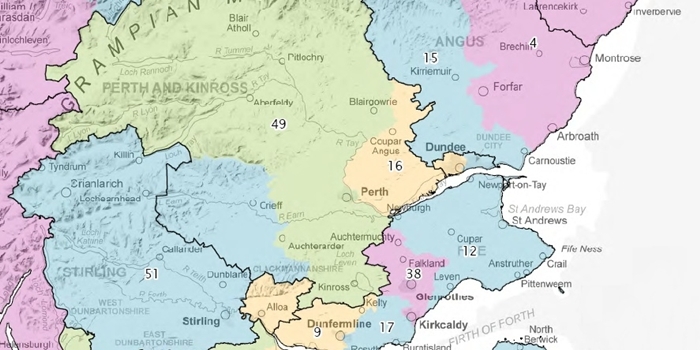Proposed changes to Scotland’s UK Parliamentary constituency boundaries have provoked a mixture of responses from politicians.
Ochil and South Perthshire MP Gordon Banks said: “I am disappointed that Clackmannanshire and South Perthshire will likely cease to exist as it has meant a lot to me.”
The publication of the Boundary Commission’s proposals marks the start of a 12-week public consultation process.
In a statement, the commission said: “Parliament has decided to reduce the number of UK Parliament constituencies from 650 to 600.
“In Scotland this means that there will be 52 constituencies instead of 59.
“Of these, two constituencies are defined in the legislation: Na h-Eileanan an Iar (the Western Isles) and Orkney and Shetland – the remaining 50 constituencies must each have between 72,810 and 80,473 electors.
“This is the first time the legislation has specified exact limits on the number of electors in each constituency.
“The commission has also had to ensure that no constituency exceeds the maximum permitted area of 13,000 square kilometres. The requirements set by parliament limit the number of possible constituency designs.
“Due to the reduction in the number of constituencies and the requirement for nearly equal numbers of electors in each constituency, it has not been possible to leave constituencies as they currently are.
“In developing its initial proposals across Scotland, the commission has tried to minimise the number of constituencies which combine parts of different council areas.
“The commission has had to divide 29 wards out of a total of 353, each between two constituencies. When dividing wards, the commission has followed community council boundaries or other recognisable boundaries.”
Hugh Buchanan, secretary to the commission said, “The commission has worked intensively to design this set of constituencies, which we believe provide a good implementation of the rules set by Parliament.
“We now want to get people’s views on these proposals so we can improve them where the legislation allows us to do so.”
The Boundary Commission for Scotland has also made available papers and minutes from its meetings when it discussed these proposals.
Under the Boundary Commission for Scotland proposals, a large swathe of Angus will come under a new Dundee East and The Glens constituency, while Forfar, Montrose, Arbroath and Brechin will become part of Angus East and Kincardine.
The Carse of Gowrie and much of the countryside east of Perth, along with Coupar Angus, will be merged into a new Dundee West and Gowrie constituency, while Crieff will be included in the new Stirling and Crieff constituency.
However, the biggest controversy is in Fife, where it is proposed to split Dunfermline in two, with one constituency including part of Clackmannanshire.
A Cupar and St Andrews constituency is also proposed, made up of 71% of the existing North East Fife area and 29% of the Glenrothes constituency, while a Kirkcaldy and Glenrothes constituency is also envisaged, taking in parts of Kirkcaldy and Cowdenbeath, Glenrothes and part of the current North East Fife area.
In Dundee the only council ward affected will be Maryfield, which will be split with 59% of voters going to the Dundee East and the Glens and the remaining 41% forming part of Dundee West and Gowrie.
Dundee East MP Stewart Hosie said: “I am delighted that two Dundee seats are to be retained in the proposals. This was the key thing for us – that the city would keep its two seats at Westminster, and this now seems certain, although the number of Scottish MPs overall will fall from 59 to 52.”
Dundee West MP Jim McGovern was more cautious, saying he would study the proposals before making his views known.
Further information on the commission’s initial proposals can be found at bcomm-scotland.gov.uk/6th_westminster/.
He said: “Dundee is a city and I would hope that any boundary changes would reflect that identity. There is now going to be a public consultation and I will make my views clear during that process.”
Angus MP Mike Weir said: “People will have to look at it and consider how it will make a difference to them. People in the Glens area will have little obvious connection with those in an urban area like Dundee.”
Dunfermline and West Fife MP Thomas Docherty slammed the plans to split Dunfermline in two as “ludicrous”.
Under the proposals 44% of his constituency would fall under the Clackmannanshire and Dunfermline West seat and 56% to Dunfermline East.
The commission is proposing a constituency combining all of Clackmannanshire council area with the western part of Fife.
Of the local authority Dunfermline Central ward, which covers the town centre, 50% would fall to Clackmannanshire and Dunfermline West and 50% to Dunfermline East.
Mr Docherty told The Courier: “I will oppose the splitting of Dunfermline town as that is going to be absolutely ludicrous. . . I will be concentrating on getting the town reunited, it would not be a big shift over.”
A spokesman for Sir Menzies Campbell, North East Fife MP, said: “We have received the Boundary Commission for Scotland’s proposals and we will digest and respond to these at the local inquiry in due course”.
Continues…
